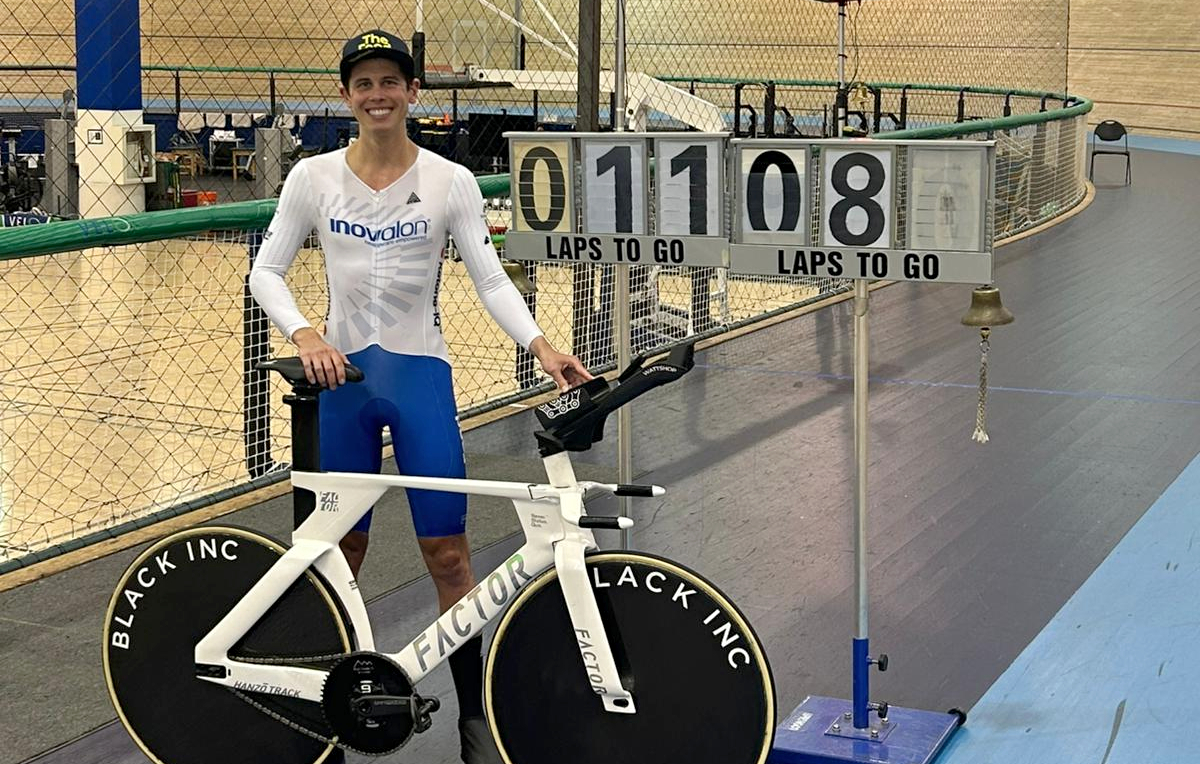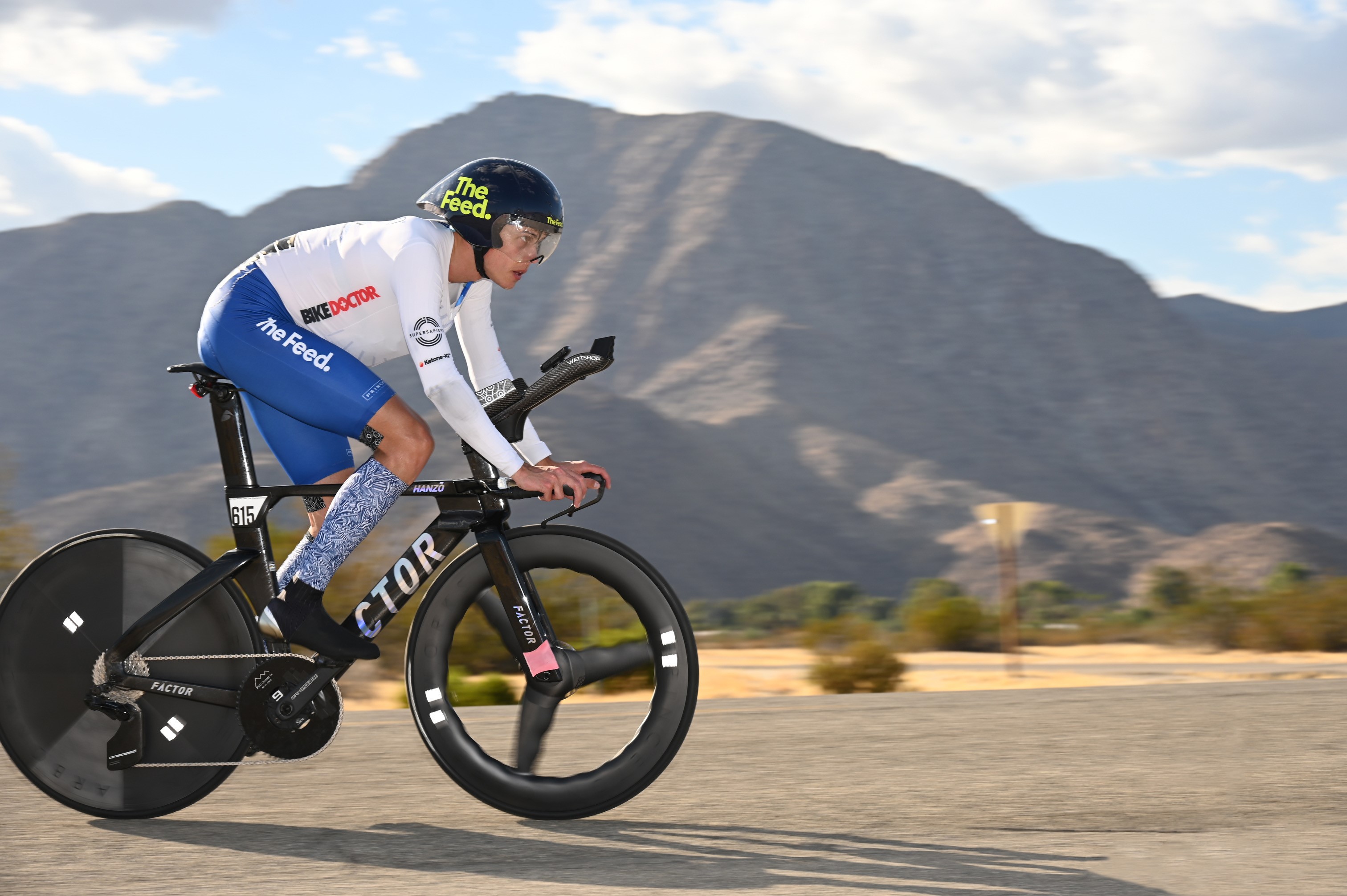
In his early twenties, Ryan Collins was told he would never ride a bike again. He has since broken 12 ultra-cycling world records, eight of which he earned late last year on the track.
The 30-year-old set the six-hour benchmark on an outdoor velodrome in September, covering 259km (161 miles), and also breaking the 100km, 200km and 100-mile records in the process. He then repeated the same set of four in mid-December, this time on an indoor velodrome, where he completed 1,108 laps in six hours, riding roughly 277km (171 miles).
Collins’s achievements come just a handful of years after he was struck head-on by a car driver while out training. At the time, he had been identified as an Olympic hopeful for Team USA’s track squad, and was due to fly out and join the team the following week.
“I was scraped off the road,” he tells Cycling Weekly. “I had several broken bones and ligaments torn in my whole body. I needed reconstructive surgery to put me back together.
“When the surgery was done, the doctor came out and said, ‘You’re never going to ride a bike again.’ I was devastated. But when someone tells you you’re never going to do something, it’s like, ‘Who are you to tell me that?’ Just watch me.”
2024
Six-Hour Indoor Velodrome (170.7 miles)
100-Mile Indoor Velodrome (03:31:42)
200km Indoor Velodrome (04:22:49)
100km Indoor Velodrome (02:10:09)
Six-Hour Outdoor Velodrome (161.08 miles)
100-Mile Outdoor Velodrome (03:43:11)
200km Outdoor Velodrome (04:39:24)
100km Outdoor Velodrome (02:19:24)
2020
Six-Hour Outdoor Road (154.32 miles)
200km Outdoor Road (04:48:59)
100km Outdoor Road (02:23:35)
Maryland State Crossing Record (North-South: 05:30)
In the weeks and months afterwards, Collins slowly rebuilt the strength to hold his handlebars, brake and shift gears. He then signed up to a 12-hour ultra-cycling event in Florida, scheduled for less than a year after the crash. “I went to the race and I was very successful,” he says. “So I came back the following year and I won, broke the course record, and started pursuing bigger events.”
His first world records came in 2020, two years after the collision, when he set new benchmarks for distance covered in six hours outdoors, as well as the fastest outdoor 200km and 100km, and time taken to cross the state of Maryland. Last January, he focused his sights on eight more, this time on the track.
“The six-hour events all came about through promises I made to my friends. We were talking about how cool it would be to break the six-hour world record for indoor velodrome, outdoor velodrome and then target the World Championships all in the same year,” he says.
“Unfortunately those friends all fought battles with depression and decided to end their fight. So this was the year that I thought to honour them and actually go out and fulfil these promises that I made to them.”
Though Collins says six hours is “not too long – it’s a long training ride”, he admits it was “incredibly hard” to maintain a comfortable position for that time. By way of training, he would wake up at four in the morning and ride on a turbo trainer for two to three hours, often in hotel rooms, before commuting to his job as a marketing executive in New Jersey.
“The biggest success came from the isolation on the indoor trainer, and just having to sit there, because there’s nowhere else to go,” he says. “I just sit in position, I have no fans, it’s hot, it’s gruelling, it’s boring, I stare at a wall, and occasionally I can play music unless I get a noise complaint.”
Still, he says, “you can be as comfortable as you like, but be as aero as a brick, so the next step was testing”.
With no access to wind tunnels, Collins did most of his testing on track, and relied on the knowledge of his equipment partners. He wore top-of-the-range kit from Rule 28, received a cockpit from aero experts Wattshop, and rode Factor’s new Olympic track bike, the Hanzo, which was released at a price tag of $59,990 (£47,217) early last year.
His first velodrome record attempt, held on the outdoor track in San Diego in September, was billed as a “trial and error” for his later indoor bid.
“Up until that point, I had not ridden six hours on the velodrome, and to be quite honest, about three weeks before the event, I wasn’t even sure I could do it. The longest I had been on a velodrome was only three hours,” Collins says.
“Riding your bike for six hours is not the same as riding a fixed gear bike for six hours. The sensation of fatigue building up in your body and your legs was something I had not done. It was an unknown.”
Two-hundred-and-fifty-nine kilometres later, Collins had banked four new records. He then travelled to Borrego Springs, a desert in California, and won the six-hour ultra-cycling World Championships, setting a new course record time.

It was in California, too, where he took on his six-hour indoor velodrome record in December. The track in Carson, located in the suburbs of Los Angeles, is the only Olympic-distance one in the country, over 2,500 miles from Collins’s east coast home in Washington DC.
Now confident in his ability to ride the track for six hours, he began his effort and quickly found himself in a “flow state”.
“That’s how you know it’s going to be a good race or a good training session,” he explains. “I don’t space out, but I can think about anything, and time passes so quickly.
“I had timing notifications on my Garmin so it would just beep. I knew that every 30 minutes I wanted to take a gel, and that kind of broke up the monotony. I had a dozen gels in my skinsuit and I would pull one out, take it, toss it. That brought me back into focus.”
Collins averaged almost 29mph (46km/h) over the time. Again, he clocked four new world records, and posed by the lap board, which counted over 1,100 laps.
“I did it,” he wrote proudly on Instagram afterwards. The message was one of affirmation, a nod to his supporters, to himself for realising his goal, and perhaps also to the doctors who told him he would never ride a bike again.
"I defied the odds," he now says, looking back. "It goes to show [what you can do] if you have a focus and put everything into rehabilitation recovery. I did everything I possibly could to do it safe and correctly, and here we are."
That crash in his early twenties, it turns out, was just the beginning of his journey.







